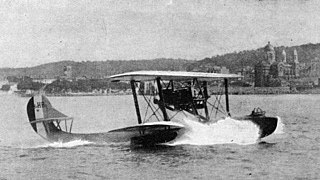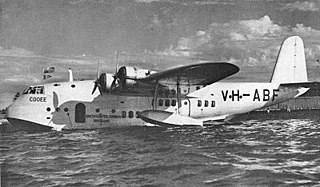
The Nord Aviation 3202 was a 1950s French military trainer aircraft designed and built by Nord Aviation to meet a French Army requirement for a two-seat basic trainer, as a replacement for the biplane Stampe SV.4. Altogether, 101 examples were built, with the first flying on 17 April 1957.

The Blanchard Brd.1 was a French reconnaissance flying boat, to the 1923 STAé HB.3 specification, used by the French navy in the 1920s. It was a large biplane with two engines mounted in the gap between the wings, each engine driving a pusher propeller. In 1924, one Brd.1 was used to set several world altitude records for seaplanes.

The CAMS 30E was a two-seat flying boat trainer built in France in the early 1920s. It was the first aircraft designed for CAMS by Raffaele Conflenti after he had been recruited by the company from his previous job at Società Idrovolanti Alta Italia (SIAI). It was a conventional design for the era featuring a two-bay equal-span unstaggered biplane wing cellule. The prototype was exhibited at the 1922 Salon de l'Aéronautique and evaluated the following year by the Aéronautique Maritime. The type's favourable performance led to an order of 22 machines for the French military and an export order of seven for Yugoslavia and four for Poland.

The CAMS 37 was a flying boat built in France in the mid-1920s that was originally designed for military reconnaissance, but which found use in a wide variety of roles in a large number of versions. It was the first design for Chantiers Aéro-Maritimes de la Seine (CAMS) by the company's new head designer, Maurice Hurel. The prototype was displayed at the 1926 Salon de l'Aéronautique in Paris. The prototype first flew in 1926, and after testing was ordered into service before the end of the year. It was a conventional biplane flying boat very similar to previous CAMS designs, being driven by a pusher propeller whose engine was mounted on struts in the interplane gap. The first production version was the amphibious CAMS 37A that was bought by the French Navy, the Portuguese Navy and the aeroclub of Martinique.

The CAMS 46 was a flying boat trainer aircraft built in France in the mid-1920s, essentially an updated version of the CAMS 30 that had flown in 1922. While retaining that aircraft's basic form, CAMS offered the French Navy two new versions with aerodynamic refinements over the earlier aircraft: the CAMS 46 E primary trainer, and the CAMS 46 ET intermediate trainer. Only the latter was selected for production and was built in quantity to supply one escadrille at the Naval training station at Hourtin.

The CAMS 55 was a reconnaissance flying boat built in France in the late 1920s which equipped the French Navy throughout the 1930s.

The FBA Type 310 was a 1930s French touring flying boat or amphibian built by the Franco-British Aviation Company.

The FBA 17 was a training flying boat produced in France in the 1920s.

The FBA 19 was a flying boat bomber developed in France in 1924 by Franco-British Aviation.

The Lioré et Olivier LeO H-180 was a 1920s French two-seat flying-boat built by Lioré et Olivier.

The Loire 30 a.k.a.Loire 300 was a French three-seat night reconnaissance monoplane designed and built by Loire Aviation of St. Nazaire.

The CAMS 36 was a 1920s French flying boat designed and built by Chantiers Aéro-Maritimes de la Seine. It was originally conceived as a single-seat fighter but evolved as a racer to compete in the 1922 Schneider Trophy race. Lack of funds in 1922 and an accident in 1923 meant the two aircraft built failed to participate in a Schneider race.
The FBA Avion Canon was a two-seat cannon-armed biplane fighter, designed and built in France from 1916. due to unsatisfactory performance, development of the Avion Canon was abandoned.
The Lioré et Olivier LeO H-22 was a French amphibian, primarily intended for aerial mail transport.
The Bloch MB.800 was a French low-wing monoplane three-seat trainer / mailplane developed by Société des Avions Marcel Bloch. It was of all-wood construction.
The CAMS 32R was an amphibious reconnaissance flying boat flown in the early 1920s. It used a monocoque fuselage.
The CAMS 90 was an amphibious observation flying boat built in the early 1930s. The wings were made of wood, but the hull was of all-metal construction. The Lorraine Mizar engine was mounted in a pusher configuration.
The FBA 10 was a reconnaissance flying boat built in France in the early 1920s.
The FBA 13 was a trainer flying boat built in France in the early 1920s.
The FBA 270 was a flying boat trainer built in France in the early 1920s.














